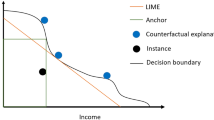Abstract
In this paper we present an approach to creating Bi-directional Decision Support System (DSS) as an intermediary between an expert (U) and a machine learning (ML) system for choosing an optimal solution. As a first step, such DSS analyzes the stability of expert decision and looks for critical values in data that support such a decision. If the expert’s decision and that of a machine learning system continue to be different, the DSS makes an attempt to explain such a discrepancy. We discuss a detailed description of this approach with examples. Three studies are included to illustrate some features of our approach.








Similar content being viewed by others
References
Baehrens D, Schroeter T, Harmeling S, Kawanabe M, Hansen K (2010) Klaus-robert Mller how to explain individual classification decisions. arXiv:0912.1128 [stat.ML] 11(jun): 18031831
Bourneffouf et al. (2016) Exponentiated gradient exploration for active learning. Computers 5:1–12
Casgrain P, Ning B, Jaimungal S (2019) Deep Q-learning for Nash equilibria: Nash-DQN. arXiv preprint arXiv:1904.10554
Cronin P, Ryan F, Coughlan M (2008) Undertaking a literature review: a step-by-step approach. Br J Nurs. 17(1):38–43
Galitsky B (2020) Employing abstract meaning representation to lay the last-mile toward reading comprehension. In: Artificial Intelligence for Customer Relationship Management: keeping customers informed, Springer, Cham
Galitsky B, Goldberg S (2019) Chapter 3 explainable machine learning for chatbots in B. Galitsky developing enterprise chatbots: learning linguistic structures. Springer, pp 57–89
Galitsky B, Shpitsberg I (2016) Autistic learning and cognition. Computational Autism, pp 245–293
Goldberg S (1997) Inference engine the systems of the dr. Watson type. DIMACS Workshop Rutgers University, New Jersey
Goldberg SI, Lomovskikh VE, Makhanek AO, Sklyar MS (1991) Expert system DINAR-2.-methodological basis for the pediatric emergency aid organization in a large region. In: Medical informatics europe, vienna, austria, 270-274
Goldberg S (2007) Nikita Shklovskiy-Kordi.; Boris Zingerman. Time-oriented multi-image case history - way to the disease image analysis. VISAPP (Special Sessions), pp 200–203
Goldberg SI, Niemierko A, Shubina M, Turchin A (2010) “Summary Page”: A novel tool that reduces omitted data in research databases. BMC Medical Research Methodology 10:91–97
Goldberg S, Katz G, Weisburd B, Belyaev A, Temkin A (2019) Integrating user opinion in decision support systems. In: Arai K, Bhatia R (eds) advances in information and communication. FICC, Lecture Notes in Networks and Systems, 70, Springer
Goldberg S, Galitsky B, Weisburd B (2019) Framework for interaction between expert users and machine learning systems. http://ceur-ws.org/vol-2448/SSS19_paper_upload_217.pdf
Goodman B, Flaxman S (2017) European Union regulations on algorithmic decision-making and a right to explanation AI Mag Magazine, 38(3)
Hansen N (2006) The CMA evolution strategy: a comparing review, Towards a new evolutionary computation. In: Advances on estimation of distribution algorithms, Springer, 1769–1776, CiteSeerX 10.1.1.139.7369
Henderson M, Tierney L, Smetana G (2012) The Patient history: evidence-based approach to differential diagnosis., McGraw-Hill, New York NY
Illankoon P, Tretten P, Kumar D (2019) Modeling human cognition of abnormal machine behavior. Human-Intelligent Systems Integration 1:13–26
Ioannis K, Andrew B, Shiying H, Tanya V, Huihan L, Spanos C (2019) A deep learning and gamification approach to improving human-building interaction and energy efficiency in smart infrastructure. Appl Energy 237:810–821
Krawczyk B, Minku LL, Gama J, Stefanowski J, Wozniak M (2017) Ensemble learning for data stream analysis: a survey. Information Fusion 37:132–156
Lee CJ, Sugimoto CR, Zhang G, Cronin B (2013) Bias in peer review. J Am Soc Inf Sci Tec 64:2–17
Manning CD, Surdeanu M, Bauer J, Finkel J, Bethard SJ (2014) Mcclosky, The stanford coreNLP natural language processing toolkit, Proceedings of 52nd Annual Meeting of the Association for Computational linguistics: System Demonstrations, pp 55–60, Baltimore, Maryland USA, June 23–24
Ribeiro MT, Singh S, Guestrin C (2016) Why Should I Trust You? Explaining the Predictions of Any Classifier. https://arxiv.org/pdf/1602.04938.pdf
Molnar C (2019) Interpretable Machine Learning. A Guide for Making Black Box Models Explainable. https://christophm.github.io/interpretable-ml-book/
NIH News in Health (2014) A monthly newsletter from the National Institutes of Health, part of the U.S. Department of Health and Human Services https://newsinhealth.nih.gov/2014/10/cold-flu-or-allergy
Plous S (1993) The psychology of judgment and decision making. McGraw-Hill, New York
Ratliff Lillian J, et al. (2014) Social game for building energy efficiency: incentive design, 52nd annual Allerton conference on communication, control, and computing. IEEE, 1011–8
Report of Neonatology (2018) Department of sverdlovsk state children hospital, Russia, 43–47
Scott M, Lundberg GGE, Lee S-I (2019) Consistent individualized feature attribution for tree ensembles. https://arxiv.org/pdf/1602.04938.pdf
Shklovsky-Kordi N, Zingerman B, Rivkind N, Goldberg S, Davis S, Varticovski L, Krol M, Kremenetzkaia AM, Vorobiev A, Serebriyskiy I (2005) Computerized case history - an effective tool for management of patients and clinical trials Engelbrecht R, et al. (eds)
Siegenthaler W (2011) Differential diagnosis in internal medicine: from symptom to diagnosis., Thieme Medical Publishers
Xiaofeng W, Tuomas S (2002) Reinforcement learning to play an optimal nash equilibrium in team Markov games. NIPS’02: Proceedings Of the 15th International Conference on Neural Information Processing Systems, January 1603–1610
Ni Z, Yu Y, Wencong S (2015) A game-theoretic economic operation of residential distribution system with high participation of distributed electricity consumers. Appl Energy 154:471–9
Author information
Authors and Affiliations
Corresponding author
Ethics declarations
Conflict of interest
The authors declare no competing interests.
Additional information
Publisher’s note
Springer Nature remains neutral with regard to jurisdictional claims in published maps and institutional affiliations.
Rights and permissions
About this article
Cite this article
Goldberg, S., Pinsky, E. & Galitsky, B. A bi-directional adversarial explainability for decision support. Hum.-Intell. Syst. Integr. 3, 1–14 (2021). https://doi.org/10.1007/s42454-021-00031-5
Received:
Accepted:
Published:
Issue Date:
DOI: https://doi.org/10.1007/s42454-021-00031-5




